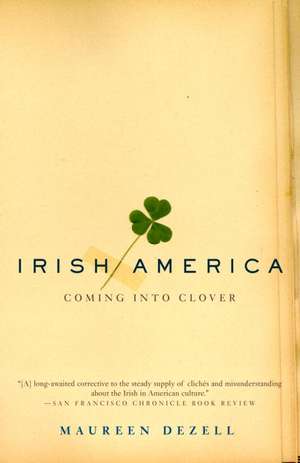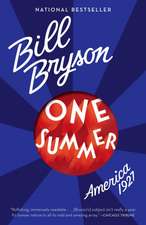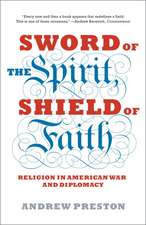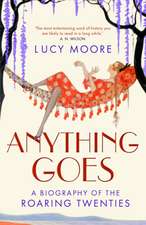Irish America: Coming Into Clover
Autor Maureen Dezellen Limba Engleză Paperback – 28 feb 2002
In Irish America, Maureen Dezell takes a new and invigorated look at Americans of Irish Catholic ancestry — who they are, and how they got that way. A welcome antidote to so many standard-issue, sentimental representations of the Irish in the United States, Irish America focuses on popular culture as well as politics; the Irish in the Midwest and West as well as the East; the “new Irish” immigrants; the complicated role of the Church today; and the unheralded heritage of Irish American women. Deftly weaving history, reporting, and the observations of more than 100 men and women of Irish descent on both sides of the Atlantic, Dezell presents an insightful and highly readable portrait of a people and a culture.
Preț: 117.58 lei
Nou
Puncte Express: 176
Preț estimativ în valută:
22.50€ • 23.44$ • 18.63£
22.50€ • 23.44$ • 18.63£
Carte disponibilă
Livrare economică 13-27 martie
Preluare comenzi: 021 569.72.76
Specificații
ISBN-13: 9780385495967
ISBN-10: 038549596X
Pagini: 276
Ilustrații: 14 PHOTOGRAPHS IN TEXT
Dimensiuni: 133 x 203 x 15 mm
Greutate: 0.25 kg
Ediția:Anchor Books.
Editura: Anchor Books
ISBN-10: 038549596X
Pagini: 276
Ilustrații: 14 PHOTOGRAPHS IN TEXT
Dimensiuni: 133 x 203 x 15 mm
Greutate: 0.25 kg
Ediția:Anchor Books.
Editura: Anchor Books
Notă biografică
Maureen Dezell is a staff writer for the Boston Globe. She lives in Brookline, Massachusetts.
Extras
Selling the Songs in Their Hearts
The Irish American Image in Popular Culture
Each year in early March, the mud thaws, the days lengthen, and advertisers roll out images of shamrocks, party-hearty leprechauns, and freckle-faced inebriates. St. Patrick's Day is fast approaching, and competition is keen to sell beer and spirits by suggesting an Irish brand endorsement--a seal of approval of sorts from the ethnic group "known" to overimbibe.
St. Patrick's Day advertising is sui generis in the realm of niche marketing, and a slogan the Leo Burnett Company came up with to sell beer one year--"Irish I had a Schlitz"--explains why. The logo was the exception that proves the rule that unflattering ethnic images are far too offensive to use in the serious American business of selling. No sane advertiser would create a commercial for Florida condominiums suggesting:
"Jewish it cost less?" None would put together a promotion for a white-shoe financial services house urging:
"Take the sting out of investing. Have WASPs watch your money."
Obnoxious caricatures of the "clever Jew," "penny-pinching Protestant," or "inscrutable Asian" have mercifully disappeared from the American mainstream. The Irish boozer still bobs about in media flotsam, not because some pernicious prejudice keeps the cliche afloat, but because Irish Americans endorse it. Drinking to wretched excess is a time-honored tradition on St. Patrick's Day in the United States, an annual occasion in which a splendid heritage is reduced to Eiresatz: a sentimental slur of imagined memories, fine feeling, and faux Irish talismans and traditions.
On the American day when everyone is Irish, lovely lasses and pugilistic Paddies parade on urban avenues carrying lucky clovers and silent harps; leering leprechauns serve as symbols of Irish wit and cunning; mawkish music and fight songs pay "tribute" to the Irish spirit; public drunkenness passes for Irish pride.
"No other ethnic group demeans itself this way," the Irish-born Los Angeles psychiatrist Garrett O'Connor has noted. "The Irish character becomes caricature" around St. Patrick's Day, "when being drunk is supposed to be the same thing as being Irish."
The New York St. Patrick's Day parade, which has long made a concerted effort to counter cultural clowning, is a caricature in its own right. A solemn, quasimilitaristic display of staunch Roman Catholicism, self-righteousness, and Irish republicanism, the event is recognized around the world as a symbol of Irish culture, when, in fact, it is not. The pageant reflects nothing so much as the membership and mind-set of the Ancient Order of Hibernians, the all-male fraternal society who organize the parade, and who once led an unsuccessful campaign to keep America safe from the Abbey Theatre. Today, they bar the equally insidious and threatening Irish Lesbian and Gay Organization from the line of march.
The essence and ethos of the New York parade were vividly expressed on a gusty, sun-warmed March 17 morning of 1999, when the late John Cardinal O'Connor greeted Irish screen actress Maureen O'Hara, grand marshal of the parade, on the steps of St. Patrick's Cathedral: conservative Catholicism meets The Quiet Man.
As the country's oldest, largest ethnic group, the Irish have been secure enough for long enough to shrug off anachronisms and hackneyed stereotypes that might raise hackles among others. Reasonable people of Celtic heritage figure that St. Patrick's Day displays are silly; life is too short to get exercised over a parade or a fifteen-second TV spot of a winking leprechaun swilling a Budweiser. Why get upset?
Why indeed.
Self-lampooning, a St. Patrick's Day staple, dates at least to vaudeville days, when struggling immigrants and their children realized that their comic sense and the songs in their hearts would sell. The stage Irishman's blarney-imbued "Don't mind me, I'm just a funny Irish guy" renditions of shuffle-alongs and happy drunks were officially hooted out of music halls and theaters in the 1900s--in a campaign led by the Ancient Order of Hibernians. But American popular culture by that time had embraced the idea that the Irish were a genial, down-to-earth, self-effacing people with a romantic past and a weakness for drink. For better and for worse, so had the Irish--which is why those notions define Irish America's image and self-image to this day.
A stage Irish story
Descendants of dreamers and tale-tellers in the land of money, myth, and Disney, the American Irish early on developed a capacity for romanticizing their heritage and sentimentalizing themselves.
The throngs who fled Ireland's Great Hunger and their children had little choice but to reinvent who they were. Famine immigrants spilled out of coffin ships into American cities "dressed in rags, weak with hunger, and numb with the fresh memory of corpse-filled workhouses, skeletal children, and tales of cannibalism," in Dennis Clark's words. They were premodern peasants, "homeless, nationless, and all but hopeless after a grim sea passage to an unwelcoming land."
Like immigrants who would later take their place on the bottom rung of the socioeconomic ladder, they represented much of what upstanding American society abhorred. The Irish were Celts, not Anglo-Saxons; Papists, not Protestants; rebels fighting to expel America's Motherland from their homeland. They were communal in a land of vaunted individualist achievers; drinkers at the dawn of the American temperance movement; a gregarious and boisterous people who showed little interest in serious American enterprise but loved politics.
Newspaper and magazine illustrators who provided visual definition for the pre-tabloid, pre-television age borrowed from British newspaper pages and vaudeville stages to reflect prevailing opinion with drawings of apelike Irish, drunken Paddys, menacing Micks, and surly Biddies. The influential cartoonist Thomas Nast "regarded the politicized Irish Celt as a menace to a good society," L. Perry Curtis Jr. writes in Apes and Angels: The Irishman in Victorian Caricature. Anytime he "drew an Irish-American, he invariably produced a . . . cross between a professional boxer and an orangutan" (see illustration, page 142).
The Irishman onstage was Sambo with a shillelagh. Actor, producer, and writer Tyrone Power (forebear of a theatrical family that would include his namesake, the movie actor, and the director Tyrone Guthrie) made himself a star in the role of "Paddy Power," a re-creation of a blabbing, blundering Irish peasant who was such a hit in London. The Paddy stage schtick called for Irish props--pigs in the parlor, whiskey--and almost always featured a fight that turned into a melee. Brawls were a trademark of Irish immigrants, who gave name to the police vehicle, the paddy wagon.
The Irish American Image in Popular Culture
Each year in early March, the mud thaws, the days lengthen, and advertisers roll out images of shamrocks, party-hearty leprechauns, and freckle-faced inebriates. St. Patrick's Day is fast approaching, and competition is keen to sell beer and spirits by suggesting an Irish brand endorsement--a seal of approval of sorts from the ethnic group "known" to overimbibe.
St. Patrick's Day advertising is sui generis in the realm of niche marketing, and a slogan the Leo Burnett Company came up with to sell beer one year--"Irish I had a Schlitz"--explains why. The logo was the exception that proves the rule that unflattering ethnic images are far too offensive to use in the serious American business of selling. No sane advertiser would create a commercial for Florida condominiums suggesting:
"Jewish it cost less?" None would put together a promotion for a white-shoe financial services house urging:
"Take the sting out of investing. Have WASPs watch your money."
Obnoxious caricatures of the "clever Jew," "penny-pinching Protestant," or "inscrutable Asian" have mercifully disappeared from the American mainstream. The Irish boozer still bobs about in media flotsam, not because some pernicious prejudice keeps the cliche afloat, but because Irish Americans endorse it. Drinking to wretched excess is a time-honored tradition on St. Patrick's Day in the United States, an annual occasion in which a splendid heritage is reduced to Eiresatz: a sentimental slur of imagined memories, fine feeling, and faux Irish talismans and traditions.
On the American day when everyone is Irish, lovely lasses and pugilistic Paddies parade on urban avenues carrying lucky clovers and silent harps; leering leprechauns serve as symbols of Irish wit and cunning; mawkish music and fight songs pay "tribute" to the Irish spirit; public drunkenness passes for Irish pride.
"No other ethnic group demeans itself this way," the Irish-born Los Angeles psychiatrist Garrett O'Connor has noted. "The Irish character becomes caricature" around St. Patrick's Day, "when being drunk is supposed to be the same thing as being Irish."
The New York St. Patrick's Day parade, which has long made a concerted effort to counter cultural clowning, is a caricature in its own right. A solemn, quasimilitaristic display of staunch Roman Catholicism, self-righteousness, and Irish republicanism, the event is recognized around the world as a symbol of Irish culture, when, in fact, it is not. The pageant reflects nothing so much as the membership and mind-set of the Ancient Order of Hibernians, the all-male fraternal society who organize the parade, and who once led an unsuccessful campaign to keep America safe from the Abbey Theatre. Today, they bar the equally insidious and threatening Irish Lesbian and Gay Organization from the line of march.
The essence and ethos of the New York parade were vividly expressed on a gusty, sun-warmed March 17 morning of 1999, when the late John Cardinal O'Connor greeted Irish screen actress Maureen O'Hara, grand marshal of the parade, on the steps of St. Patrick's Cathedral: conservative Catholicism meets The Quiet Man.
As the country's oldest, largest ethnic group, the Irish have been secure enough for long enough to shrug off anachronisms and hackneyed stereotypes that might raise hackles among others. Reasonable people of Celtic heritage figure that St. Patrick's Day displays are silly; life is too short to get exercised over a parade or a fifteen-second TV spot of a winking leprechaun swilling a Budweiser. Why get upset?
Why indeed.
Self-lampooning, a St. Patrick's Day staple, dates at least to vaudeville days, when struggling immigrants and their children realized that their comic sense and the songs in their hearts would sell. The stage Irishman's blarney-imbued "Don't mind me, I'm just a funny Irish guy" renditions of shuffle-alongs and happy drunks were officially hooted out of music halls and theaters in the 1900s--in a campaign led by the Ancient Order of Hibernians. But American popular culture by that time had embraced the idea that the Irish were a genial, down-to-earth, self-effacing people with a romantic past and a weakness for drink. For better and for worse, so had the Irish--which is why those notions define Irish America's image and self-image to this day.
A stage Irish story
Descendants of dreamers and tale-tellers in the land of money, myth, and Disney, the American Irish early on developed a capacity for romanticizing their heritage and sentimentalizing themselves.
The throngs who fled Ireland's Great Hunger and their children had little choice but to reinvent who they were. Famine immigrants spilled out of coffin ships into American cities "dressed in rags, weak with hunger, and numb with the fresh memory of corpse-filled workhouses, skeletal children, and tales of cannibalism," in Dennis Clark's words. They were premodern peasants, "homeless, nationless, and all but hopeless after a grim sea passage to an unwelcoming land."
Like immigrants who would later take their place on the bottom rung of the socioeconomic ladder, they represented much of what upstanding American society abhorred. The Irish were Celts, not Anglo-Saxons; Papists, not Protestants; rebels fighting to expel America's Motherland from their homeland. They were communal in a land of vaunted individualist achievers; drinkers at the dawn of the American temperance movement; a gregarious and boisterous people who showed little interest in serious American enterprise but loved politics.
Newspaper and magazine illustrators who provided visual definition for the pre-tabloid, pre-television age borrowed from British newspaper pages and vaudeville stages to reflect prevailing opinion with drawings of apelike Irish, drunken Paddys, menacing Micks, and surly Biddies. The influential cartoonist Thomas Nast "regarded the politicized Irish Celt as a menace to a good society," L. Perry Curtis Jr. writes in Apes and Angels: The Irishman in Victorian Caricature. Anytime he "drew an Irish-American, he invariably produced a . . . cross between a professional boxer and an orangutan" (see illustration, page 142).
The Irishman onstage was Sambo with a shillelagh. Actor, producer, and writer Tyrone Power (forebear of a theatrical family that would include his namesake, the movie actor, and the director Tyrone Guthrie) made himself a star in the role of "Paddy Power," a re-creation of a blabbing, blundering Irish peasant who was such a hit in London. The Paddy stage schtick called for Irish props--pigs in the parlor, whiskey--and almost always featured a fight that turned into a melee. Brawls were a trademark of Irish immigrants, who gave name to the police vehicle, the paddy wagon.
Recenzii
"With a fabulous blend of eloquence and anecdote, insight and compassion, candor and wit, Maureen Dezell has brilliantly captured the Irish experience in America. This is truly a wonderful book."
--Doris Kearns Goodwin, author of The Fitzgeralds and the Kennedys and No Ordinary Time
"With this sparkling and shrewd portrait of a culture in transition, Maureen Dezell joins the ranks of the Irish American woman journalists who are as smart as they are charming."
--Nuala O'Faolain, author of Are You Somebody?
"At last a book that dispels so much of the myth, the fairy tale, the rose-tinted, shamrock-gilded blarney that has come to represent the way Irish-American culture is often seen. Maureen Dezell gives us a vibrant, cogent social history of the Irish in this country, rooting out the cliches and stereotyping that have come to define a people. For that alone, I feel indebted to this marvelous book."
--Dennis Lehane, bestselling author of A Drink Before the War and Prayers for Rain
"Maureen Dezell is an unrepentant truth teller. With wit, insight and unsparing intelligence she succeeds in demolishing the convenient time-worn stereotypes - comforting as well as insulting - that surround Irish America. In their place, she gives us a portrait of a people as they really are, with all their strengths, and contradictions, and enduring sense of self. Irish America: Coming Into Clover is a wonderful achievement."
--Peter Quinn, author of Banished Children of Eve
"With 'Irish America: Coming Into Clover,' Maureen Dezell has done tremendous identity-affirming service for all Irish Americans who have ever been confronted by the all too familiar assault, 'just who do you think you are?' Dezell's brilliant exploration illuminates for all, the Irish American character, in its multi-layered, diverse, and sometimes paradoxical glory. And she does so in prose that mirrors that same character. This is not a traditional text, for it is written by an Irish American, herself as witty, hilarious, literary, and gifted at storytelling, as the very best of the Irish artists and social analysts she writes about.
The artistic, social, and psychological history in these pages also reveals many paths that may traverse beyond the limits of shame, stereotype, and self defeat, into an American landscape, already lush with Irish contributions in art, altruism, diversity, and a sense of community."
--Michael Patrick MacDonald, author of All Souls: A Family Story from Southie
“[A] long-awaited corrective to the steady supply of clich?s and misunderstanding about the Irish in American culture.” —San Francisco Chronicle Book Review
“A fascinating book that debunks myths and skewers stereotypes.” —The Atlanta Journal-Constitution
“A very good, sometimes witty, sometimes sad book about Irish Americans, who they are and how they came to be.” —The Philadelphia Inquirer
--Doris Kearns Goodwin, author of The Fitzgeralds and the Kennedys and No Ordinary Time
"With this sparkling and shrewd portrait of a culture in transition, Maureen Dezell joins the ranks of the Irish American woman journalists who are as smart as they are charming."
--Nuala O'Faolain, author of Are You Somebody?
"At last a book that dispels so much of the myth, the fairy tale, the rose-tinted, shamrock-gilded blarney that has come to represent the way Irish-American culture is often seen. Maureen Dezell gives us a vibrant, cogent social history of the Irish in this country, rooting out the cliches and stereotyping that have come to define a people. For that alone, I feel indebted to this marvelous book."
--Dennis Lehane, bestselling author of A Drink Before the War and Prayers for Rain
"Maureen Dezell is an unrepentant truth teller. With wit, insight and unsparing intelligence she succeeds in demolishing the convenient time-worn stereotypes - comforting as well as insulting - that surround Irish America. In their place, she gives us a portrait of a people as they really are, with all their strengths, and contradictions, and enduring sense of self. Irish America: Coming Into Clover is a wonderful achievement."
--Peter Quinn, author of Banished Children of Eve
"With 'Irish America: Coming Into Clover,' Maureen Dezell has done tremendous identity-affirming service for all Irish Americans who have ever been confronted by the all too familiar assault, 'just who do you think you are?' Dezell's brilliant exploration illuminates for all, the Irish American character, in its multi-layered, diverse, and sometimes paradoxical glory. And she does so in prose that mirrors that same character. This is not a traditional text, for it is written by an Irish American, herself as witty, hilarious, literary, and gifted at storytelling, as the very best of the Irish artists and social analysts she writes about.
The artistic, social, and psychological history in these pages also reveals many paths that may traverse beyond the limits of shame, stereotype, and self defeat, into an American landscape, already lush with Irish contributions in art, altruism, diversity, and a sense of community."
--Michael Patrick MacDonald, author of All Souls: A Family Story from Southie
“[A] long-awaited corrective to the steady supply of clich?s and misunderstanding about the Irish in American culture.” —San Francisco Chronicle Book Review
“A fascinating book that debunks myths and skewers stereotypes.” —The Atlanta Journal-Constitution
“A very good, sometimes witty, sometimes sad book about Irish Americans, who they are and how they came to be.” —The Philadelphia Inquirer
Descriere
Skillfully weaving history and reporting, Dezell traces the changing makeup of the Irish population in this country, from the early immigrants to today's affluent, educated Irish Americans. Photos.













